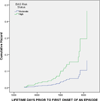High Behavioral Approach System (BAS) sensitivity, reward responsiveness, and goal-striving predict first onset of bipolar spectrum disorders: a prospective behavioral high-risk design
- PMID: 22004113
- PMCID: PMC3403678
- DOI: 10.1037/a0025877
High Behavioral Approach System (BAS) sensitivity, reward responsiveness, and goal-striving predict first onset of bipolar spectrum disorders: a prospective behavioral high-risk design
Abstract
A prospective, behavioral high-risk design provided a theoretically guided examination of vulnerability to first onset of bipolar spectrum disorder based on the Behavioral Approach System (BAS) model. Adolescents (ages 14-19) at an "age of risk" for bipolar disorder onset were screened on BAS sensitivity by interviewers blind to current symptoms, lifetime history, and family history of psychopathology. Participants were selected with high versus moderate levels of BAS sensitivity and administered a lifetime diagnostic interview. Those with a bipolar spectrum disorder, psychosis, or hypomanic episode with onset prior to the BAS sensitivity assessment were excluded. High BAS (n = 171) and moderate BAS (n = 119) sensitivity participants in the final sample completed baseline measures of symptoms, goal-setting, and reward responsiveness and were followed prospectively with semistructured diagnostic interviews every 6 months. Consistent with the vulnerability hypothesis of the BAS model of bipolar disorder, high BAS participants had a greater likelihood, and shorter time to onset, of bipolar spectrum disorder than moderate BAS participants across an average of 12.8 months of follow-up (12.9% vs. 4.2%), controlling for baseline depressive and hypomanic symptoms, and family history of bipolar disorder. High reward responsiveness on a behavioral task and ambitious goal-striving for popular fame and financial success (but not impulsivity) also predicted first onset of bipolar spectrum disorder controlling for the covariates and BAS risk group, and ambitious goal-striving partially mediated the BAS risk group effect. We discuss implications of the findings for the BAS model of bipolar disorder and early intervention efforts.
Figures
References
-
- Akiskal HS, Bourgeois ML, Angst J, Post R, Moller H, Hirschfeld R. Re-evaluation the prevalence of and diagnostic composition within the broad clinical spectrum of bipolar disorders. Journal of Affective Disorders. 2000;59(Suppl 1):S5–S30. - PubMed
-
- Akiskal HS, Djenderedjian AH, Rosenthal RH, Khani MK. Cyclothymic disorder: Validating criteria for inclusion in the bipolar affective group. American Journal of Psychiatry. 1977;134:1227–1233. - PubMed
-
- Al-Adawi S, Powell JH. The influence of smoking on reward responsiveness and cognitive functions: A natural experiment. Addiction. 1997;92:1773–1782. - PubMed
-
- Al-Adawi S, Powell JH, Greenwood RJ. Motivational deficits after brain injury: A neuropsychological approach using new assessment techniques. Neuropsychology. 1998;12:115–124. - PubMed


